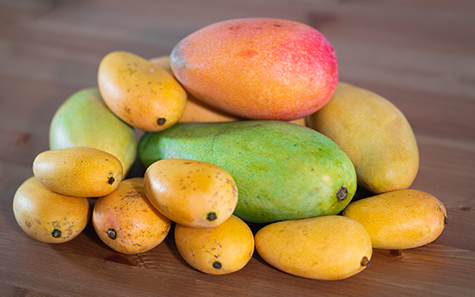Mangoes: All Hail the ‘King of Fruits’!

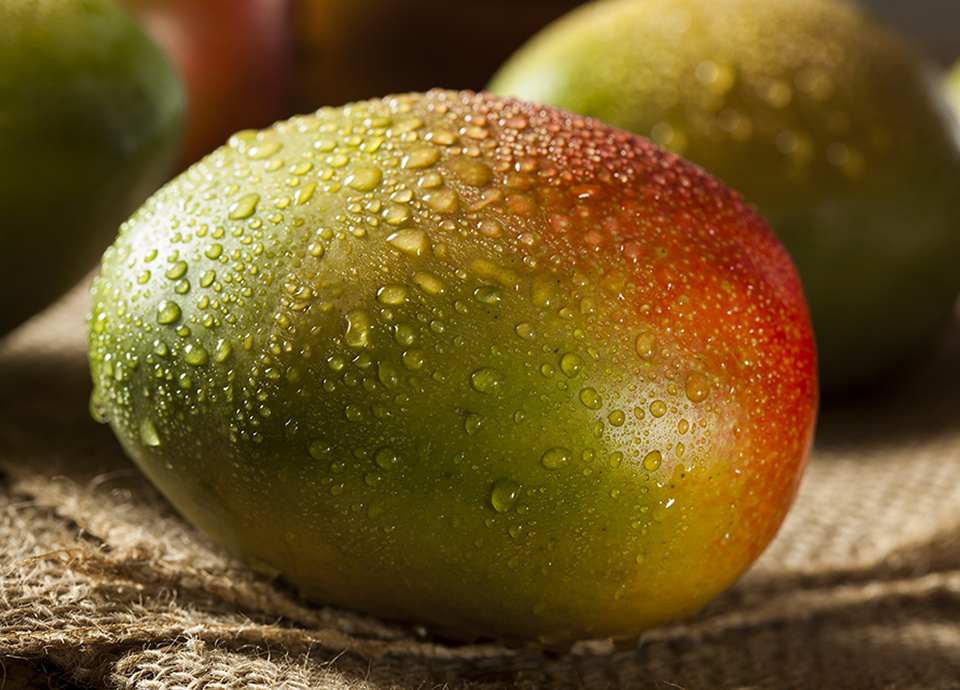
For those of us who grew up in Southeast Asia, mangoes are as common there as apples are here in North America—they are everywhere and in just about everything. My mom encouraged me to eat mangoes every day and I was happy to oblige. They are delicious with a wonderful, tropical scent and a flavor that’s a cross between pineapple and a luscious, ripe peach. The juicy flesh has a smooth, silky texture. Originally cultivated at the foot of the Himalayas 4,000 years ago, mangoes are one of the most popular fruits in the world. Right now is the beginning of the peak season for mangoes, but because there are a number of varieties grown all over the world, you can probably find fresh mangoes in the produce department of your market all year long. With their wealth of healthful properties and luxurious taste, mangoes have earned the title, the ‘King of Fruits.’
Here are some reasons that will make you happy to include mangoes in your diet. Mangoes:
- Are a high volume food – Mangoes contain a high percentage of water, so they have relatively few calories for their size—135 for a whole mango.
- Help prevent cancer — Research suggests antioxidant compounds in mangoes have been found to help to protect against colon, breast, leukemia and prostate cancers.
- Lower cholesterol – Mangoes contain high levels of fiber, pectin and vitamin C. These help lower serum cholesterol levels, specifically LDL or ‘bad’ cholesterol.
- Are good for your skin – Mangoes contain beta-carotene, which the body converts to vitamin A. They also contain 76% of the RDA of vitamin C, which helps the skin repair itself.
- Promote eye health – A cup of diced mangoes supplies 25% of the needed daily value of vitamin A, which is important to help improve night vision, prevent eye dryness and overall eye health.
- Alkalize the body – Mangoes contain tartaric acid, malic acid, and a trace of citric acid, which help to maintain the proper PH of the body. This aids digestion, sleep, lessens arthritis and reduces yeast in the system.
- Regulate blood sugar –– Mangoes have a relatively low glycemic index (41-60) so moderate quantities will not spike your sugar levels despite its sweet favor.
- Improve digestion – Like papayas, mangoes contain enzymes for breaking down protein. The 3.5 grams of fiber in a whole mango also helps digestion and regularity.
- Rehydrate you and are a remedy for heat stroke – According to traditional Indian or ayurvedic medicine, people lose fluids and become exhausted in hot climates, which can overload the kidneys with toxins. The juice of green mango mixed with water and a sweetener like honey helps to cool down the body and replenish fluids. The potassium in mangoes also helps regulate blood pressure.
- Boost your immune system –– The vitamin C and vitamin A in mangoes, plus 25 different kinds of carotenoids and other essential vitamins and minerals such as vitamin K, calcium and phosphorous, keep your immune system working effectively.
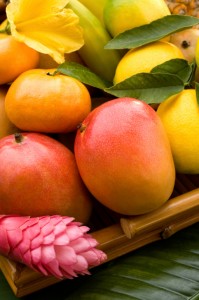 There are hundreds of mango varieties grown throughout the world, and six of them are the main varieties available in the United States. The mangos we buy come mostly from Mexico, Ecuador, Peru, Brazil, Guatemala and Haiti. These countries harvest their mango crops at different times of the year, so we get to enjoy mangos all year round. Mangoes have two seasons, one in the spring/summer and one in the fall/winter.
There are hundreds of mango varieties grown throughout the world, and six of them are the main varieties available in the United States. The mangos we buy come mostly from Mexico, Ecuador, Peru, Brazil, Guatemala and Haiti. These countries harvest their mango crops at different times of the year, so we get to enjoy mangos all year round. Mangoes have two seasons, one in the spring/summer and one in the fall/winter.
I’m very partial to the Ataulfos which are a lot like the ones in the Philippines. They are golden in color and have a relatively small seed, so there’s more of the juicy flesh, and they don’t have the slight aftertaste that some mangoes have. Ataulfos are available fresh March through July. The Kent variety is mostly green on the outside and very good for juicing. It’s available January to March and June to August. The most commonly grown mangoes in the U.S. are the Tommy Atkins which have distinctive green skins with a pinkish-red blush.
Semi-ripe mangoes are tarter than fully ripe mangoes and hold their shape better. I like to use them in my Mango Shrimp Cocktail, my Mango Shakes and my Mango Preserve (see recipes below). If you like more sweetness, use ripe mangos instead of green ones.
Mango Shrimp Cocktail
Serves 4
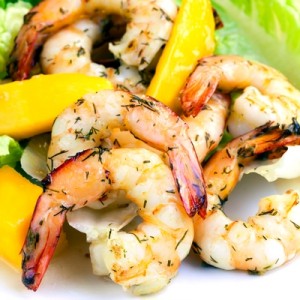 Ingredients:
Ingredients:
½ cup fresh lime juice
¼ cup sliced scallions
2 tsp. sliced jalapenos
1–2 tsp. sea salt
1–2 tsp. hot sauce
2 cups diced green (semi-ripe) mangoes
1½ cups diced Roma tomatoes
1 cup julienned young coconut meat
¼ cup minced cilantro
2 cups medium wild shrimp, steamed or grilled
Tortilla chips
Procedure
1. In a glass bowl, combine the lime juice, scallions, jalapenos, salt, and hot sauce.
2. Fold in the mangoes, tomatoes, coconut meat, and cilantro.
3. Carefully fold in shrimp.
4. Chill in the refrigerator for at least 2 hours.
5. Spoon into martini glasses.
NOTE: Depending on your taste for spicy foods, you can adjust the amount of hot sauce and jalapenos.
Green Mango Shake
Serves 2
INGREDIENTS
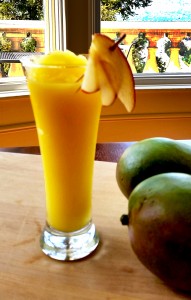 For Syrup:
For Syrup:
½ cup xylitol or refined organic sugar
2 Tbs. water
For Shake:
1 cup green mango meat, diced (Tommy Atkins mangoes)
1 cup crushed ice
½ cup water
- For syrup: Boil water and sugar for 5 minutes without stirring on medium-high heat. Set aside to cool.
- Once syrup has cooled, measure 4-6 Tbs. (depending on desired sweetness) and mix all ingredients in a blender until well mixed and the consistency of a slushy.
Ripe Mango Shake
Serves 2
INGREDIENTS
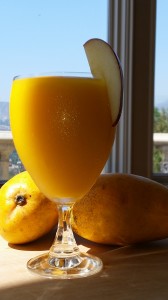 For Syrup (optional):
For Syrup (optional):
¼ cup xylitol or refined organic sugar
1 Tbs. water
For Shake:
1 cup sweet, ripe mango meat, diced (Ataulfos mangoes)
1 cup crushed ice
½ cup water
- For syrup (optional): Boil water and sugar for 5 minutes without stirring on medium-high heat. Set aside to cool.
- Mix all ingredients in a blender until well mixed and the consistency of a slushy. If you are adding the syrup, be sure it has cooled to room temperature.
NOTE: Ripe mangoes are pretty sweet, so you may not need to add syrup unless you prefer a sweeter shake.
Mango Preserves
Yields 2 cups
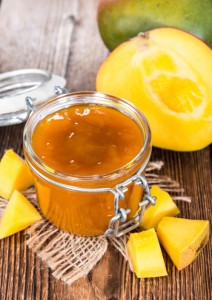 INGREDIENTS
INGREDIENTS
8 cups of ripe Ataulfos mango, mashed
½ cup sugar or xylitol
- Peel mangoes. Remove and discard seed. Cut the fruit into slices.
- Mash mango slices with a potato masher.
- Cook mango in a copper saucepan on high heat until it comes to a boil.
- Reduce heat to low-medium and cook for 30-to-35 minutes until the sauce thickens, stirring occasionally.
- Add sugar and continue cooking for 30 minutes until mixture is thick, stirring occasionally.
- Remove from heat and let cool.
